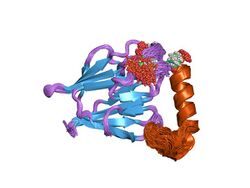Biology:MKI67IP
From HandWiki
Short description: Protein-coding gene in humans
 Generic protein structure example |
| FHA Ki67 binding domain of hNIFK | |||||||||
|---|---|---|---|---|---|---|---|---|---|
 the solution structure of the ki67fha/hnifk(226-269)3p complex | |||||||||
| Identifiers | |||||||||
| Symbol | hNIFK_binding | ||||||||
| Pfam | PF12196 | ||||||||
| InterPro | IPR021043 | ||||||||
| |||||||||
MKI67 FHA domain-interacting nucleolar phosphoprotein is a protein that in humans is encoded by the MKI67IP gene.[1][2]
MKI67 FHA domain-interacting nucleolar phosphoprotein contains an RNA recognition motif (RRM) near to the N-terminus and a FHA Ki67 binding domain near to the C-terminus. There are two conserved sequence motifs within the FHA Ki67 binding domain: TPVCTP and LERRKS, this domain binds to the forkhead-associated domain of human Ki67. High-affinity binding requires sequential phosphorylation by two kinases, CDK1 and GSK3, yielding pThr238, pThr234 and pSer230. This interaction is involved in cell cycle regulation.[3]
References
- ↑ "A novel nucleolar protein, NIFK, interacts with the forkhead associated domain of Ki-67 antigen in mitosis". J Biol Chem 276 (27): 25386–91. Jul 2001. doi:10.1074/jbc.M102227200. PMID 11342549.
- ↑ "Entrez Gene: MKI67IP MKI67 (FHA domain) interacting nucleolar phosphoprotein". https://www.ncbi.nlm.nih.gov/sites/entrez?Db=gene&Cmd=ShowDetailView&TermToSearch=84365.
- ↑ "Sequential phosphorylation and multisite interactions characterize specific target recognition by the FHA domain of Ki67". Nat. Struct. Mol. Biol. 12 (11): 987–93. November 2005. doi:10.1038/nsmb1008. PMID 16244663.
Further reading
- "Functional proteomic analysis of human nucleolus.". Mol. Biol. Cell 13 (11): 4100–9. 2003. doi:10.1091/mbc.E02-05-0271. PMID 12429849.
- "Generation and initial analysis of more than 15,000 full-length human and mouse cDNA sequences.". Proc. Natl. Acad. Sci. U.S.A. 99 (26): 16899–903. 2003. doi:10.1073/pnas.242603899. PMID 12477932. Bibcode: 2002PNAS...9916899M.
- "Structure of human Ki67 FHA domain and its binding to a phosphoprotein fragment from hNIFK reveal unique recognition sites and new views to the structural basis of FHA domain functions.". J. Mol. Biol. 335 (1): 371–81. 2004. doi:10.1016/j.jmb.2003.10.032. PMID 14659764.
- "The status, quality, and expansion of the NIH full-length cDNA project: the Mammalian Gene Collection (MGC).". Genome Res. 14 (10B): 2121–7. 2004. doi:10.1101/gr.2596504. PMID 15489334.
- "Nucleolar proteome dynamics.". Nature 433 (7021): 77–83. 2005. doi:10.1038/nature03207. PMID 15635413. Bibcode: 2005Natur.433...77A.
- "Generation and annotation of the DNA sequences of human chromosomes 2 and 4.". Nature 434 (7034): 724–31. 2005. doi:10.1038/nature03466. PMID 15815621. Bibcode: 2005Natur.434..724H.
- "Sequential phosphorylation and multisite interactions characterize specific target recognition by the FHA domain of Ki67.". Nat. Struct. Mol. Biol. 12 (11): 987–93. 2006. doi:10.1038/nsmb1008. PMID 16244663.
- "Phosphoproteome analysis of the human mitotic spindle.". Proc. Natl. Acad. Sci. U.S.A. 103 (14): 5391–6. 2006. doi:10.1073/pnas.0507066103. PMID 16565220. Bibcode: 2006PNAS..103.5391N.
External links
- PDBe-KB provides an overview of all the structure information available in the PDB for Human MKI67 FHA domain-interacting nucleolar phosphoprotein (MKI67IP)
 |


